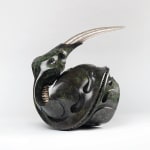Steve Dilworth British, b. 1949
20 7/8 x 17 3/4 x 17 3/4 in
Further images
"Porpoise Evolution III is another work that combines two metals and is the final work in a series of sculptures that focus on evolution.
Shown for the first time together here in London, the series starts with the simple, curved, almost cellular, form of Evolution I which is smooth and irresistably tactile. Evolution II takes on a simple plated carapace which left empty leaves the viewer to ponder what creature it once protected. Skipping a few millenia of evolutionary change Evolution III has developed into an elegant imaginary creature with a fully articulated spine of sterling silver. Originating from the carcass of a porpoise washed up on the rocky beach outside Dilworth’s home, we are invited to look within the work, past the carapace to a precious inner core." - Polly Bielecka
The landscape of eastern Harris is both rugged and beautiful in the extreme, with exposed rock three thousand million years old left by scouring glaciers from the last ice age. The energy and presence of such surroundings are powerfully conveyed in Dilworth’s work, having made the island his home since 1983. Dilworth is renowned for using a vast range of natural materials, mostly found on the island. Indeed, Dilworth used ‘once-living’ objects in his work long before it was fashionable in contemporary art.
The internal and external parts of his sculptures are considered equally – many are containers holding other elements, some visible, some not. His ritualised method of construction adds a shamanistic quality to his work. This primitivist element is almost always present, although some of his elegant formal carvings owe more to a modernist inspiration.







